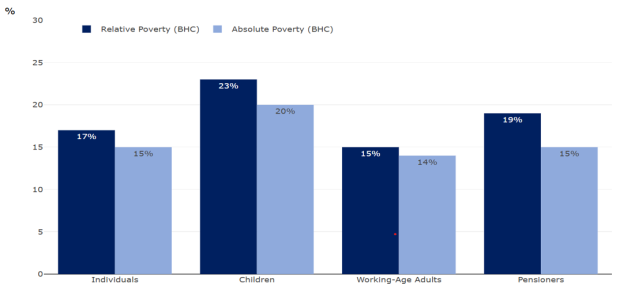23% of children are living in relative poverty
Date published:
Site topics:
People and communities
NISRA statisticians in the Department for Communities have released the latest poverty and income inequality report covering the period 2023/24

In 2023/24
- 17% of individuals (approx. 331,000 people) were estimated to be living in relative poverty (before housing costs); compared to 18% in 2022/23.
- The percentage of individuals in absolute poverty (before housing costs) stood at 15% (approx. 291,000 people); compared to 14% in 2022/23.
The percentage of children living in relative poverty (before housing costs) was 23%; compared to 24% in 2022/23. - Children living in absolute poverty (before housing costs) rose from 19% to 20% from 2022/23.
- The proportion of working age adults in relative poverty (before housing costs) was 15%; a fall from 17% in 2022/23.
- The absolute poverty (before housing costs) rate for working age adults changed from 13% in 2022/23 to 14% in 2023/24.
- When considering pensioner poverty, the After Housing Costs analysis is the preferred measure. This is because over four fifths of pensioners live in homes that are owned outright (compared to less than a third of working-age adults), and so face minimal housing costs.
- In 2023/24 the proportion of pensioners in relative poverty (after housing costs) was 12%; the same as in 2022/23. Over the same period, absolute poverty (after housing costs) for pensioners increased from 7% to 9%.
None of these changes were statistically significant.
Definitions:
- An individual is considered to be in relative poverty if they are living in a household with an income below 60% of UK median income in the year in question. In 2023/24 the threshold was £390 per week (BHC) for a couple with no children (the benchmark for HBAI). Therefore, a couple with no children that have a combined income below £390 per week would be considered to be in relative poverty.
- An individual is considered to be in absolute poverty if they are living in a household with an income below 60% of the inflation-adjusted 2010/11 UK median income. In 2023/24 the threshold was £370 per week (BHC) for a couple with no children. Therefore, a couple with no children that have a combined income below £370 per week would be considered to be in absolute poverty.”
About the publication
This statistical release provides information on:
- Individuals, working age adults, children and pensioners in poverty.
- Income inequality
- Housing costs and poverty by tenure
- Household food security
- Food bank usage
Read the full report: Northern Ireland Poverty and Income Inequality report 2023-24